Risk Assessment and Management Plan for MacVille Cafes (MGMT49)
VerifiedAdded on 2020/03/02
|58
|11424
|445
Report
AI Summary
This report provides a comprehensive risk management analysis for MacVille cafes, focusing on the existing Hurley's cafe and the planned expansion to Toowoomba. It begins with an assessment of the scope, goals, and stakeholders involved, followed by detailed PEST and SWOT analyses to identify external and internal factors influencing the business. The report outlines a risk management process, including stakeholder communication plans and the development of a risk management profile. It then delves into identifying and describing potential risks, conducting risk evaluations, and proposing risk treatments. Furthermore, the report includes risk analysis, likelihood and consequence assessment, and the development of a risk management plan, including qualitative risk analysis and a risk register, culminating in risk management strategies for Hurley's cafe. Finally, the report addresses specific assessment tasks, providing detailed answers and referencing relevant literature.
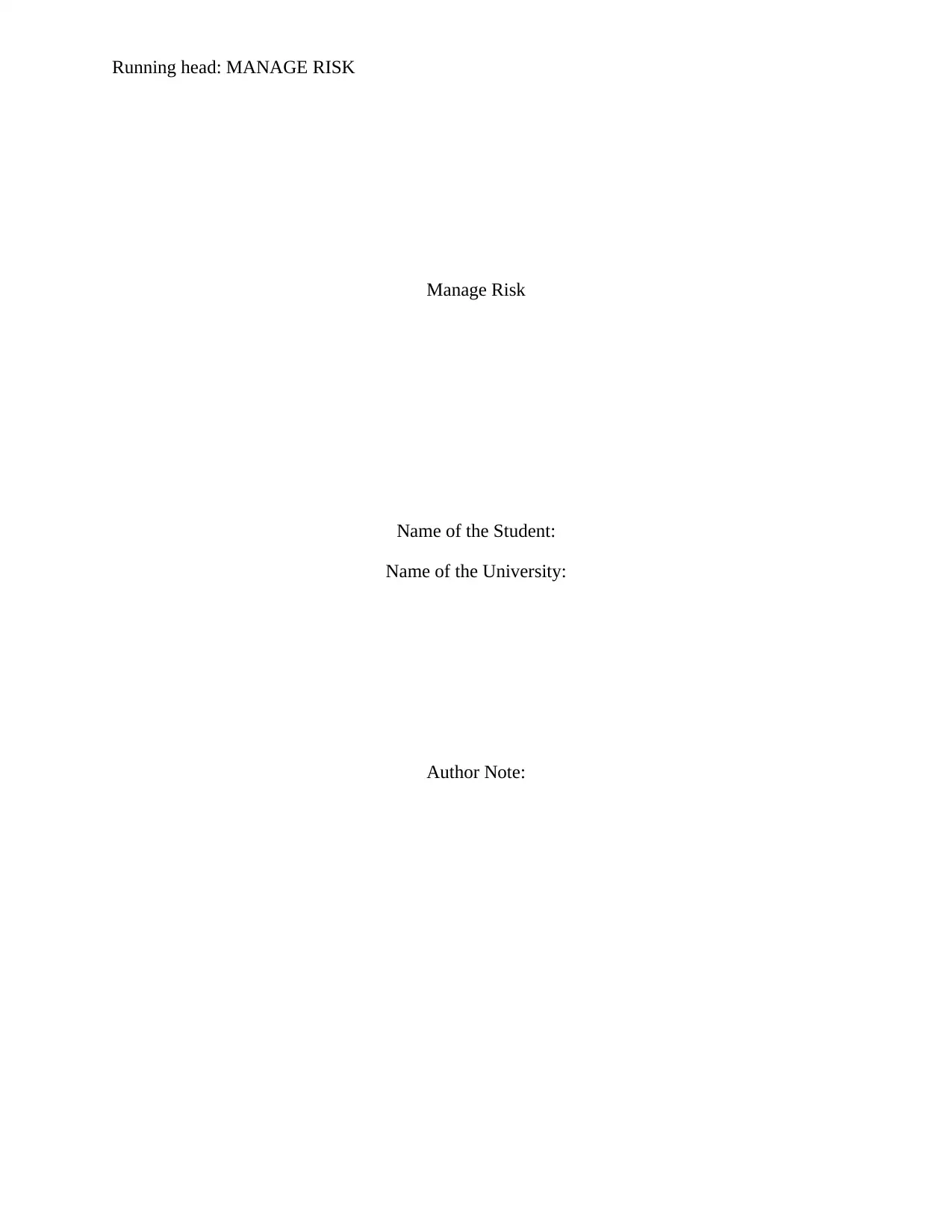
Running head: MANAGE RISK
Manage Risk
Name of the Student:
Name of the University:
Author Note:
Manage Risk
Name of the Student:
Name of the University:
Author Note:
Paraphrase This Document
Need a fresh take? Get an instant paraphrase of this document with our AI Paraphraser
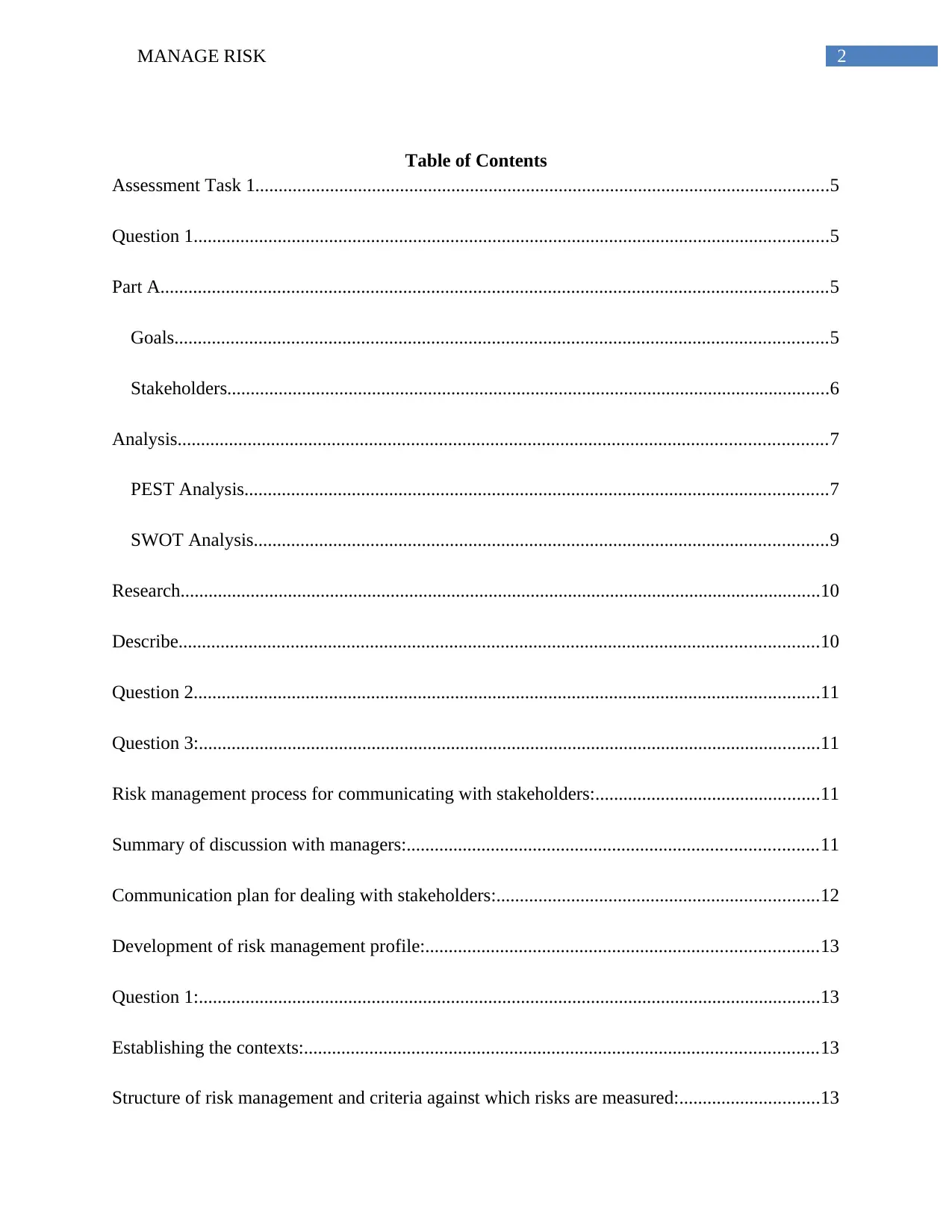
2MANAGE RISK
Table of Contents
Assessment Task 1...........................................................................................................................5
Question 1........................................................................................................................................5
Part A...............................................................................................................................................5
Goals............................................................................................................................................5
Stakeholders.................................................................................................................................6
Analysis...........................................................................................................................................7
PEST Analysis.............................................................................................................................7
SWOT Analysis...........................................................................................................................9
Research.........................................................................................................................................10
Describe.........................................................................................................................................10
Question 2......................................................................................................................................11
Question 3:.....................................................................................................................................11
Risk management process for communicating with stakeholders:................................................11
Summary of discussion with managers:........................................................................................11
Communication plan for dealing with stakeholders:.....................................................................12
Development of risk management profile:....................................................................................13
Question 1:.....................................................................................................................................13
Establishing the contexts:..............................................................................................................13
Structure of risk management and criteria against which risks are measured:..............................13
Table of Contents
Assessment Task 1...........................................................................................................................5
Question 1........................................................................................................................................5
Part A...............................................................................................................................................5
Goals............................................................................................................................................5
Stakeholders.................................................................................................................................6
Analysis...........................................................................................................................................7
PEST Analysis.............................................................................................................................7
SWOT Analysis...........................................................................................................................9
Research.........................................................................................................................................10
Describe.........................................................................................................................................10
Question 2......................................................................................................................................11
Question 3:.....................................................................................................................................11
Risk management process for communicating with stakeholders:................................................11
Summary of discussion with managers:........................................................................................11
Communication plan for dealing with stakeholders:.....................................................................12
Development of risk management profile:....................................................................................13
Question 1:.....................................................................................................................................13
Establishing the contexts:..............................................................................................................13
Structure of risk management and criteria against which risks are measured:..............................13
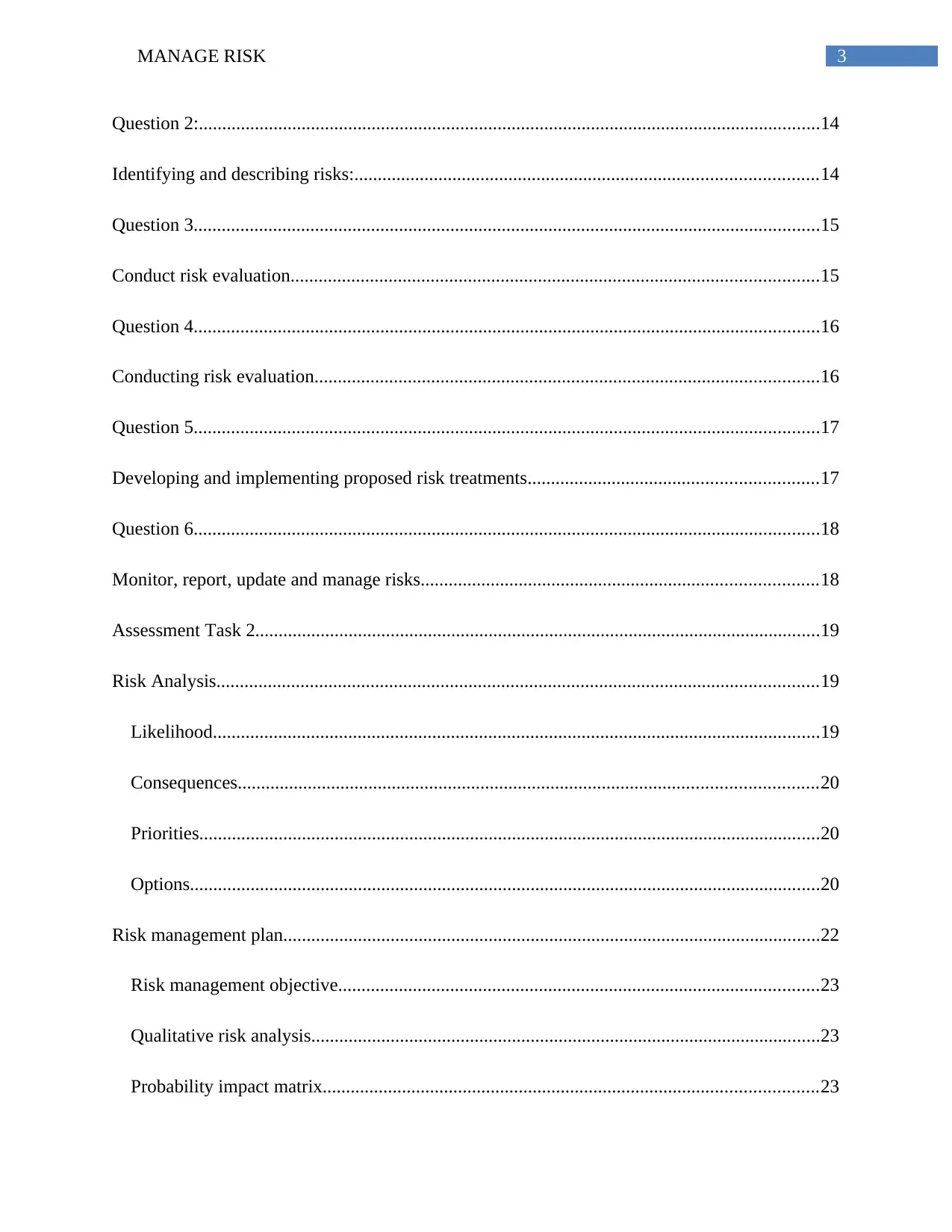
3MANAGE RISK
Question 2:.....................................................................................................................................14
Identifying and describing risks:...................................................................................................14
Question 3......................................................................................................................................15
Conduct risk evaluation.................................................................................................................15
Question 4......................................................................................................................................16
Conducting risk evaluation............................................................................................................16
Question 5......................................................................................................................................17
Developing and implementing proposed risk treatments..............................................................17
Question 6......................................................................................................................................18
Monitor, report, update and manage risks.....................................................................................18
Assessment Task 2.........................................................................................................................19
Risk Analysis.................................................................................................................................19
Likelihood..................................................................................................................................19
Consequences............................................................................................................................20
Priorities.....................................................................................................................................20
Options.......................................................................................................................................20
Risk management plan...................................................................................................................22
Risk management objective.......................................................................................................23
Qualitative risk analysis.............................................................................................................23
Probability impact matrix..........................................................................................................23
Question 2:.....................................................................................................................................14
Identifying and describing risks:...................................................................................................14
Question 3......................................................................................................................................15
Conduct risk evaluation.................................................................................................................15
Question 4......................................................................................................................................16
Conducting risk evaluation............................................................................................................16
Question 5......................................................................................................................................17
Developing and implementing proposed risk treatments..............................................................17
Question 6......................................................................................................................................18
Monitor, report, update and manage risks.....................................................................................18
Assessment Task 2.........................................................................................................................19
Risk Analysis.................................................................................................................................19
Likelihood..................................................................................................................................19
Consequences............................................................................................................................20
Priorities.....................................................................................................................................20
Options.......................................................................................................................................20
Risk management plan...................................................................................................................22
Risk management objective.......................................................................................................23
Qualitative risk analysis.............................................................................................................23
Probability impact matrix..........................................................................................................23
⊘ This is a preview!⊘
Do you want full access?
Subscribe today to unlock all pages.

Trusted by 1+ million students worldwide
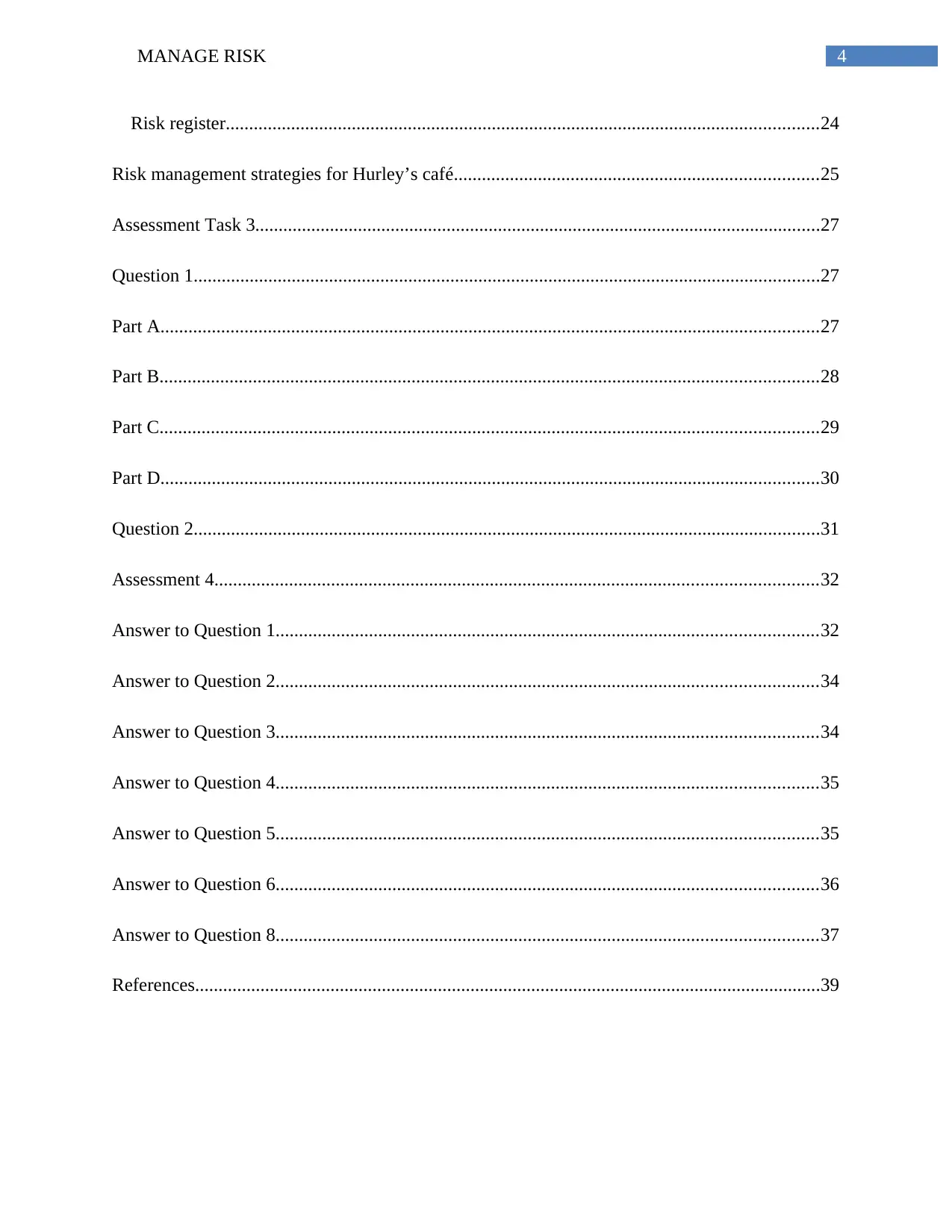
4MANAGE RISK
Risk register...............................................................................................................................24
Risk management strategies for Hurley’s café..............................................................................25
Assessment Task 3.........................................................................................................................27
Question 1......................................................................................................................................27
Part A.............................................................................................................................................27
Part B.............................................................................................................................................28
Part C.............................................................................................................................................29
Part D.............................................................................................................................................30
Question 2......................................................................................................................................31
Assessment 4.................................................................................................................................32
Answer to Question 1....................................................................................................................32
Answer to Question 2....................................................................................................................34
Answer to Question 3....................................................................................................................34
Answer to Question 4....................................................................................................................35
Answer to Question 5....................................................................................................................35
Answer to Question 6....................................................................................................................36
Answer to Question 8....................................................................................................................37
References......................................................................................................................................39
Risk register...............................................................................................................................24
Risk management strategies for Hurley’s café..............................................................................25
Assessment Task 3.........................................................................................................................27
Question 1......................................................................................................................................27
Part A.............................................................................................................................................27
Part B.............................................................................................................................................28
Part C.............................................................................................................................................29
Part D.............................................................................................................................................30
Question 2......................................................................................................................................31
Assessment 4.................................................................................................................................32
Answer to Question 1....................................................................................................................32
Answer to Question 2....................................................................................................................34
Answer to Question 3....................................................................................................................34
Answer to Question 4....................................................................................................................35
Answer to Question 5....................................................................................................................35
Answer to Question 6....................................................................................................................36
Answer to Question 8....................................................................................................................37
References......................................................................................................................................39
Paraphrase This Document
Need a fresh take? Get an instant paraphrase of this document with our AI Paraphraser
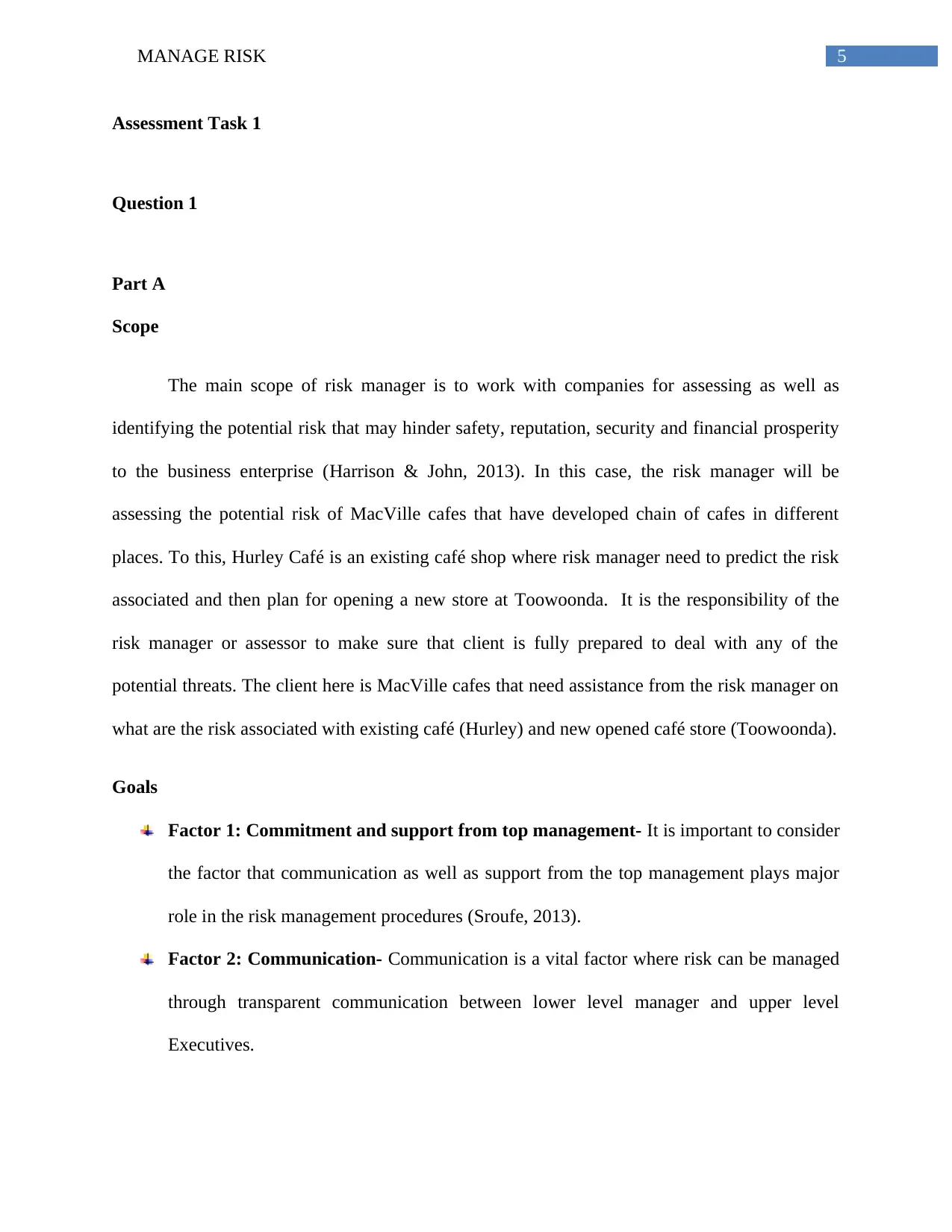
5MANAGE RISK
Assessment Task 1
Question 1
Part A
Scope
The main scope of risk manager is to work with companies for assessing as well as
identifying the potential risk that may hinder safety, reputation, security and financial prosperity
to the business enterprise (Harrison & John, 2013). In this case, the risk manager will be
assessing the potential risk of MacVille cafes that have developed chain of cafes in different
places. To this, Hurley Café is an existing café shop where risk manager need to predict the risk
associated and then plan for opening a new store at Toowoonda. It is the responsibility of the
risk manager or assessor to make sure that client is fully prepared to deal with any of the
potential threats. The client here is MacVille cafes that need assistance from the risk manager on
what are the risk associated with existing café (Hurley) and new opened café store (Toowoonda).
Goals
Factor 1: Commitment and support from top management- It is important to consider
the factor that communication as well as support from the top management plays major
role in the risk management procedures (Sroufe, 2013).
Factor 2: Communication- Communication is a vital factor where risk can be managed
through transparent communication between lower level manager and upper level
Executives.
Assessment Task 1
Question 1
Part A
Scope
The main scope of risk manager is to work with companies for assessing as well as
identifying the potential risk that may hinder safety, reputation, security and financial prosperity
to the business enterprise (Harrison & John, 2013). In this case, the risk manager will be
assessing the potential risk of MacVille cafes that have developed chain of cafes in different
places. To this, Hurley Café is an existing café shop where risk manager need to predict the risk
associated and then plan for opening a new store at Toowoonda. It is the responsibility of the
risk manager or assessor to make sure that client is fully prepared to deal with any of the
potential threats. The client here is MacVille cafes that need assistance from the risk manager on
what are the risk associated with existing café (Hurley) and new opened café store (Toowoonda).
Goals
Factor 1: Commitment and support from top management- It is important to consider
the factor that communication as well as support from the top management plays major
role in the risk management procedures (Sroufe, 2013).
Factor 2: Communication- Communication is a vital factor where risk can be managed
through transparent communication between lower level manager and upper level
Executives.
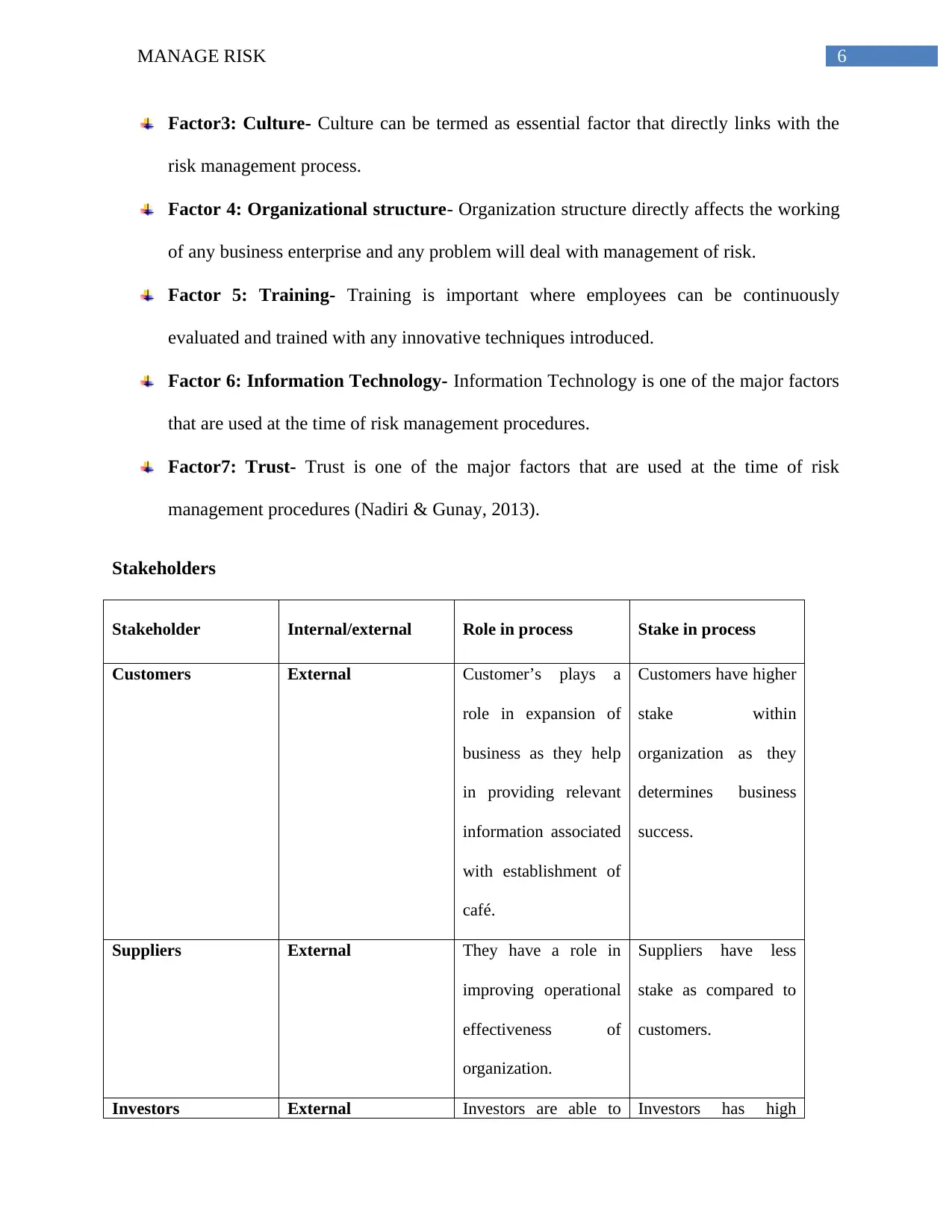
6MANAGE RISK
Factor3: Culture- Culture can be termed as essential factor that directly links with the
risk management process.
Factor 4: Organizational structure- Organization structure directly affects the working
of any business enterprise and any problem will deal with management of risk.
Factor 5: Training- Training is important where employees can be continuously
evaluated and trained with any innovative techniques introduced.
Factor 6: Information Technology- Information Technology is one of the major factors
that are used at the time of risk management procedures.
Factor7: Trust- Trust is one of the major factors that are used at the time of risk
management procedures (Nadiri & Gunay, 2013).
Stakeholders
Stakeholder Internal/external Role in process Stake in process
Customers External Customer’s plays a
role in expansion of
business as they help
in providing relevant
information associated
with establishment of
café.
Customers have higher
stake within
organization as they
determines business
success.
Suppliers External They have a role in
improving operational
effectiveness of
organization.
Suppliers have less
stake as compared to
customers.
Investors External Investors are able to Investors has high
Factor3: Culture- Culture can be termed as essential factor that directly links with the
risk management process.
Factor 4: Organizational structure- Organization structure directly affects the working
of any business enterprise and any problem will deal with management of risk.
Factor 5: Training- Training is important where employees can be continuously
evaluated and trained with any innovative techniques introduced.
Factor 6: Information Technology- Information Technology is one of the major factors
that are used at the time of risk management procedures.
Factor7: Trust- Trust is one of the major factors that are used at the time of risk
management procedures (Nadiri & Gunay, 2013).
Stakeholders
Stakeholder Internal/external Role in process Stake in process
Customers External Customer’s plays a
role in expansion of
business as they help
in providing relevant
information associated
with establishment of
café.
Customers have higher
stake within
organization as they
determines business
success.
Suppliers External They have a role in
improving operational
effectiveness of
organization.
Suppliers have less
stake as compared to
customers.
Investors External Investors are able to Investors has high
⊘ This is a preview!⊘
Do you want full access?
Subscribe today to unlock all pages.

Trusted by 1+ million students worldwide
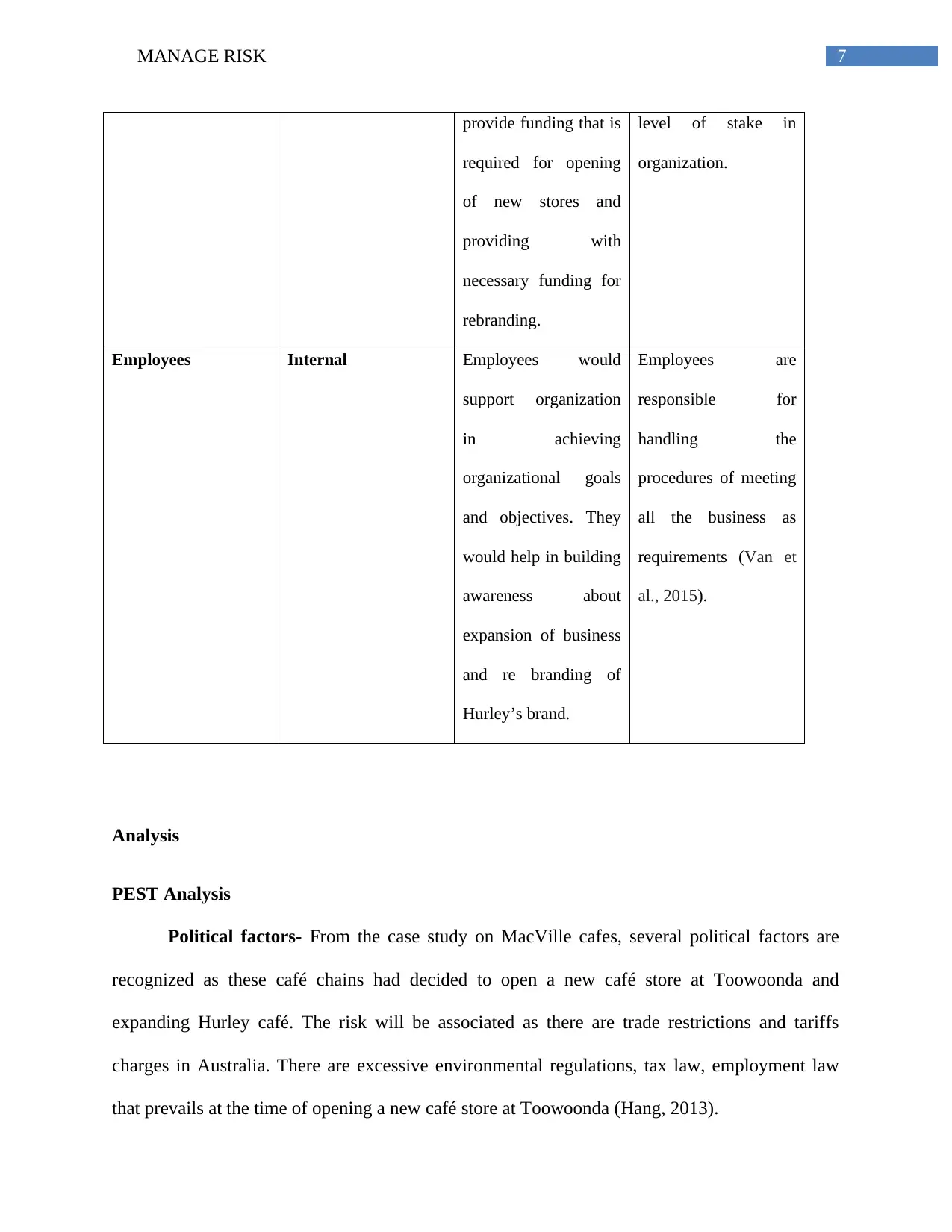
7MANAGE RISK
provide funding that is
required for opening
of new stores and
providing with
necessary funding for
rebranding.
level of stake in
organization.
Employees Internal Employees would
support organization
in achieving
organizational goals
and objectives. They
would help in building
awareness about
expansion of business
and re branding of
Hurley’s brand.
Employees are
responsible for
handling the
procedures of meeting
all the business as
requirements (Van et
al., 2015).
Analysis
PEST Analysis
Political factors- From the case study on MacVille cafes, several political factors are
recognized as these café chains had decided to open a new café store at Toowoonda and
expanding Hurley café. The risk will be associated as there are trade restrictions and tariffs
charges in Australia. There are excessive environmental regulations, tax law, employment law
that prevails at the time of opening a new café store at Toowoonda (Hang, 2013).
provide funding that is
required for opening
of new stores and
providing with
necessary funding for
rebranding.
level of stake in
organization.
Employees Internal Employees would
support organization
in achieving
organizational goals
and objectives. They
would help in building
awareness about
expansion of business
and re branding of
Hurley’s brand.
Employees are
responsible for
handling the
procedures of meeting
all the business as
requirements (Van et
al., 2015).
Analysis
PEST Analysis
Political factors- From the case study on MacVille cafes, several political factors are
recognized as these café chains had decided to open a new café store at Toowoonda and
expanding Hurley café. The risk will be associated as there are trade restrictions and tariffs
charges in Australia. There are excessive environmental regulations, tax law, employment law
that prevails at the time of opening a new café store at Toowoonda (Hang, 2013).
Paraphrase This Document
Need a fresh take? Get an instant paraphrase of this document with our AI Paraphraser
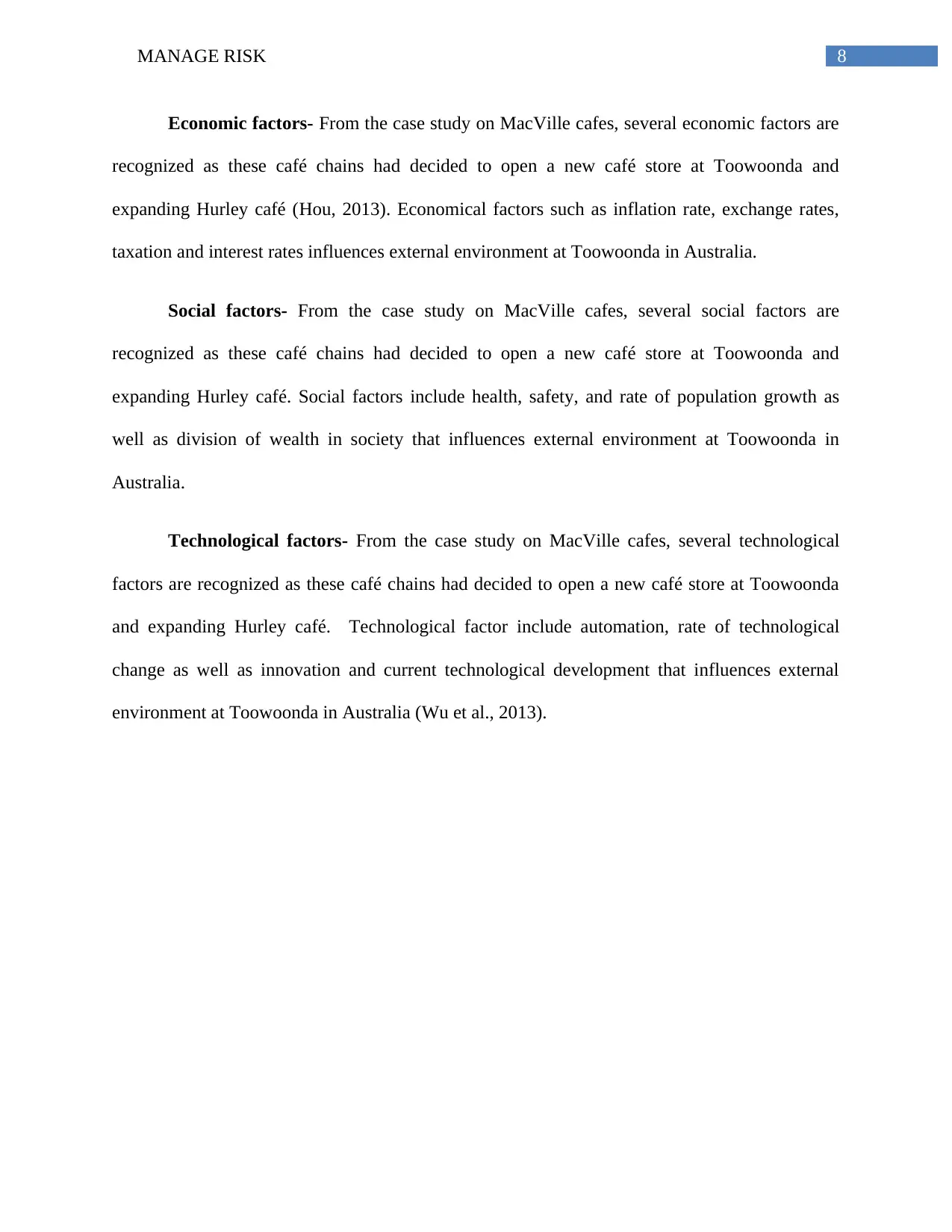
8MANAGE RISK
Economic factors- From the case study on MacVille cafes, several economic factors are
recognized as these café chains had decided to open a new café store at Toowoonda and
expanding Hurley café (Hou, 2013). Economical factors such as inflation rate, exchange rates,
taxation and interest rates influences external environment at Toowoonda in Australia.
Social factors- From the case study on MacVille cafes, several social factors are
recognized as these café chains had decided to open a new café store at Toowoonda and
expanding Hurley café. Social factors include health, safety, and rate of population growth as
well as division of wealth in society that influences external environment at Toowoonda in
Australia.
Technological factors- From the case study on MacVille cafes, several technological
factors are recognized as these café chains had decided to open a new café store at Toowoonda
and expanding Hurley café. Technological factor include automation, rate of technological
change as well as innovation and current technological development that influences external
environment at Toowoonda in Australia (Wu et al., 2013).
Economic factors- From the case study on MacVille cafes, several economic factors are
recognized as these café chains had decided to open a new café store at Toowoonda and
expanding Hurley café (Hou, 2013). Economical factors such as inflation rate, exchange rates,
taxation and interest rates influences external environment at Toowoonda in Australia.
Social factors- From the case study on MacVille cafes, several social factors are
recognized as these café chains had decided to open a new café store at Toowoonda and
expanding Hurley café. Social factors include health, safety, and rate of population growth as
well as division of wealth in society that influences external environment at Toowoonda in
Australia.
Technological factors- From the case study on MacVille cafes, several technological
factors are recognized as these café chains had decided to open a new café store at Toowoonda
and expanding Hurley café. Technological factor include automation, rate of technological
change as well as innovation and current technological development that influences external
environment at Toowoonda in Australia (Wu et al., 2013).
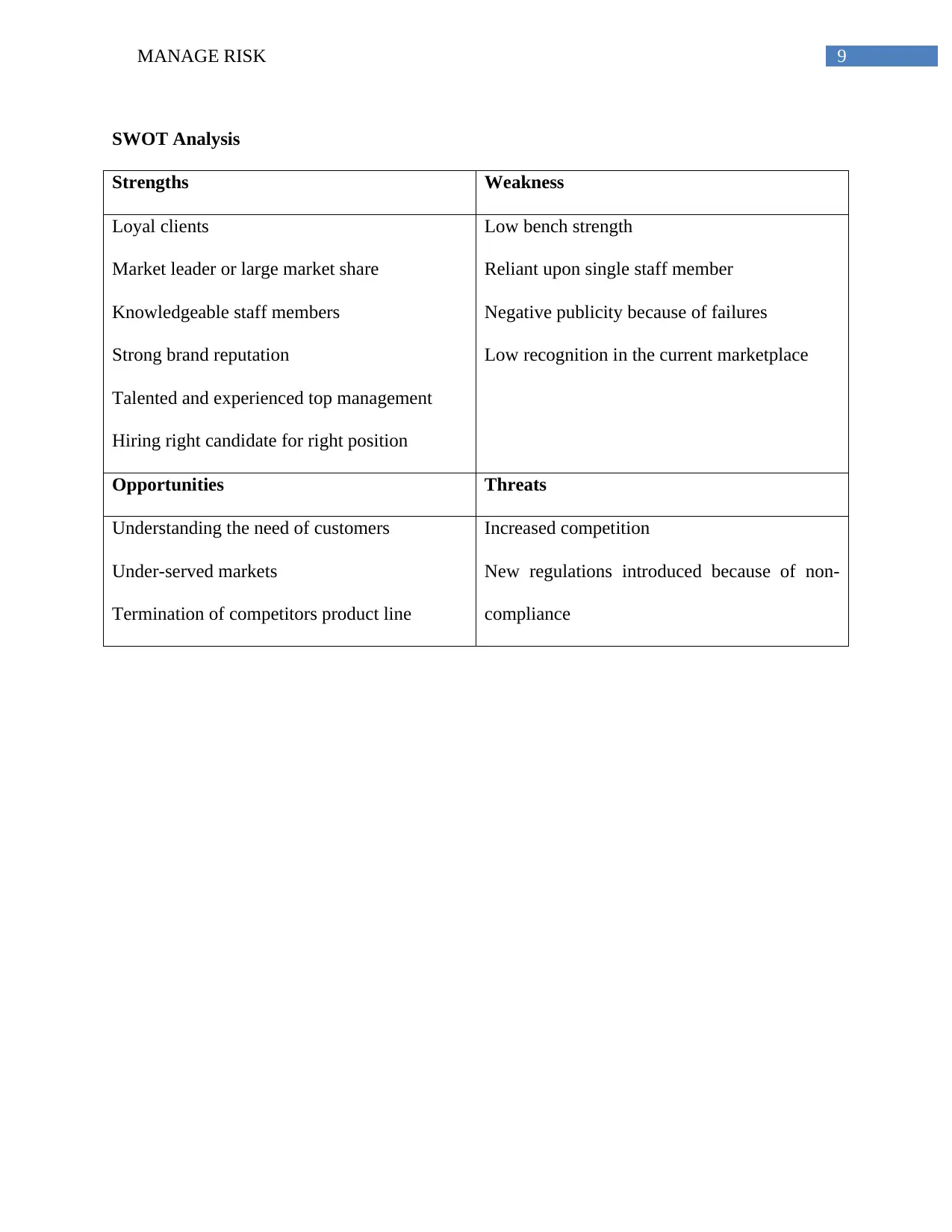
9MANAGE RISK
SWOT Analysis
Strengths Weakness
Loyal clients
Market leader or large market share
Knowledgeable staff members
Strong brand reputation
Talented and experienced top management
Hiring right candidate for right position
Low bench strength
Reliant upon single staff member
Negative publicity because of failures
Low recognition in the current marketplace
Opportunities Threats
Understanding the need of customers
Under-served markets
Termination of competitors product line
Increased competition
New regulations introduced because of non-
compliance
SWOT Analysis
Strengths Weakness
Loyal clients
Market leader or large market share
Knowledgeable staff members
Strong brand reputation
Talented and experienced top management
Hiring right candidate for right position
Low bench strength
Reliant upon single staff member
Negative publicity because of failures
Low recognition in the current marketplace
Opportunities Threats
Understanding the need of customers
Under-served markets
Termination of competitors product line
Increased competition
New regulations introduced because of non-
compliance
⊘ This is a preview!⊘
Do you want full access?
Subscribe today to unlock all pages.

Trusted by 1+ million students worldwide
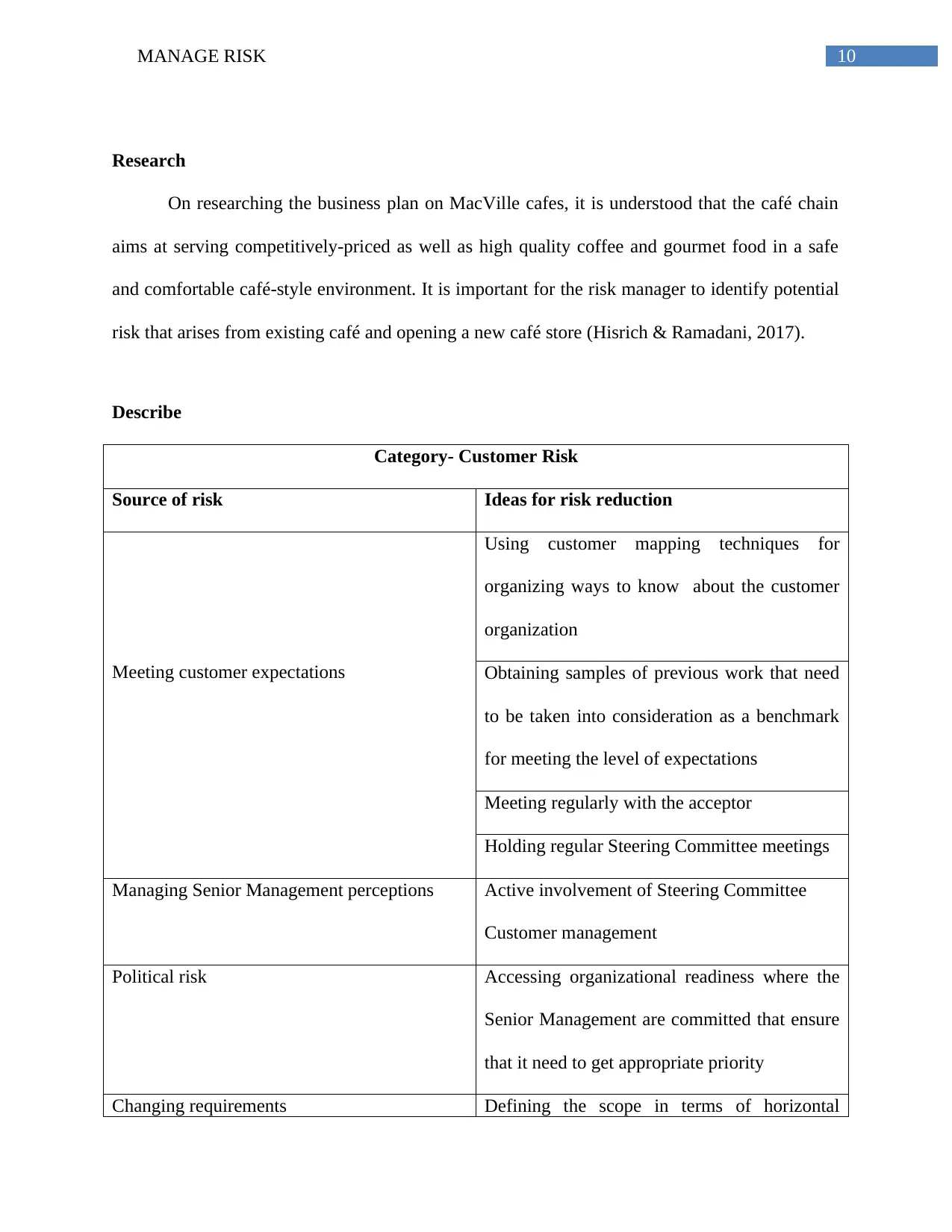
10MANAGE RISK
Research
On researching the business plan on MacVille cafes, it is understood that the café chain
aims at serving competitively-priced as well as high quality coffee and gourmet food in a safe
and comfortable café-style environment. It is important for the risk manager to identify potential
risk that arises from existing café and opening a new café store (Hisrich & Ramadani, 2017).
Describe
Category- Customer Risk
Source of risk Ideas for risk reduction
Meeting customer expectations
Using customer mapping techniques for
organizing ways to know about the customer
organization
Obtaining samples of previous work that need
to be taken into consideration as a benchmark
for meeting the level of expectations
Meeting regularly with the acceptor
Holding regular Steering Committee meetings
Managing Senior Management perceptions Active involvement of Steering Committee
Customer management
Political risk Accessing organizational readiness where the
Senior Management are committed that ensure
that it need to get appropriate priority
Changing requirements Defining the scope in terms of horizontal
Research
On researching the business plan on MacVille cafes, it is understood that the café chain
aims at serving competitively-priced as well as high quality coffee and gourmet food in a safe
and comfortable café-style environment. It is important for the risk manager to identify potential
risk that arises from existing café and opening a new café store (Hisrich & Ramadani, 2017).
Describe
Category- Customer Risk
Source of risk Ideas for risk reduction
Meeting customer expectations
Using customer mapping techniques for
organizing ways to know about the customer
organization
Obtaining samples of previous work that need
to be taken into consideration as a benchmark
for meeting the level of expectations
Meeting regularly with the acceptor
Holding regular Steering Committee meetings
Managing Senior Management perceptions Active involvement of Steering Committee
Customer management
Political risk Accessing organizational readiness where the
Senior Management are committed that ensure
that it need to get appropriate priority
Changing requirements Defining the scope in terms of horizontal
Paraphrase This Document
Need a fresh take? Get an instant paraphrase of this document with our AI Paraphraser
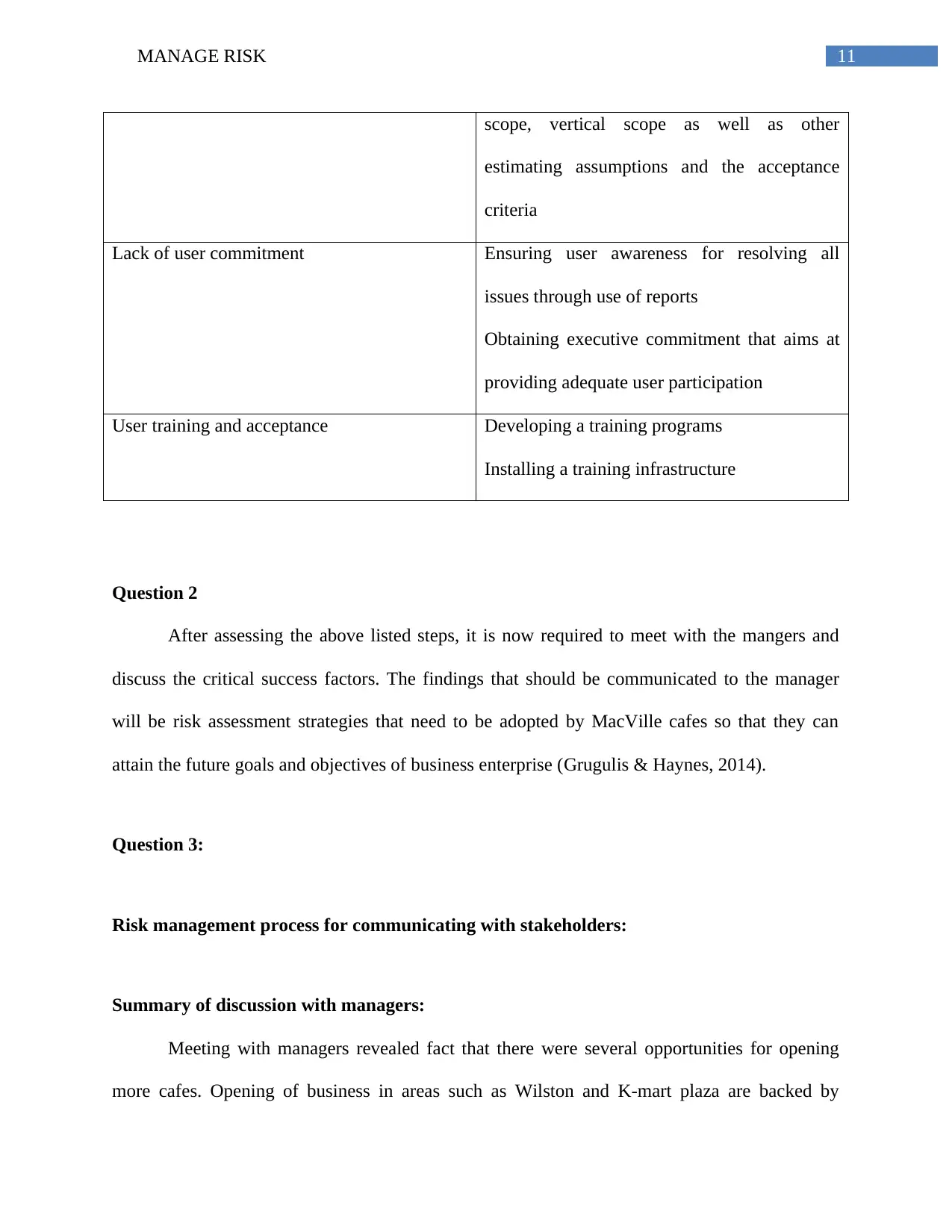
11MANAGE RISK
scope, vertical scope as well as other
estimating assumptions and the acceptance
criteria
Lack of user commitment Ensuring user awareness for resolving all
issues through use of reports
Obtaining executive commitment that aims at
providing adequate user participation
User training and acceptance Developing a training programs
Installing a training infrastructure
Question 2
After assessing the above listed steps, it is now required to meet with the mangers and
discuss the critical success factors. The findings that should be communicated to the manager
will be risk assessment strategies that need to be adopted by MacVille cafes so that they can
attain the future goals and objectives of business enterprise (Grugulis & Haynes, 2014).
Question 3:
Risk management process for communicating with stakeholders:
Summary of discussion with managers:
Meeting with managers revealed fact that there were several opportunities for opening
more cafes. Opening of business in areas such as Wilston and K-mart plaza are backed by
scope, vertical scope as well as other
estimating assumptions and the acceptance
criteria
Lack of user commitment Ensuring user awareness for resolving all
issues through use of reports
Obtaining executive commitment that aims at
providing adequate user participation
User training and acceptance Developing a training programs
Installing a training infrastructure
Question 2
After assessing the above listed steps, it is now required to meet with the mangers and
discuss the critical success factors. The findings that should be communicated to the manager
will be risk assessment strategies that need to be adopted by MacVille cafes so that they can
attain the future goals and objectives of business enterprise (Grugulis & Haynes, 2014).
Question 3:
Risk management process for communicating with stakeholders:
Summary of discussion with managers:
Meeting with managers revealed fact that there were several opportunities for opening
more cafes. Opening of business in areas such as Wilston and K-mart plaza are backed by
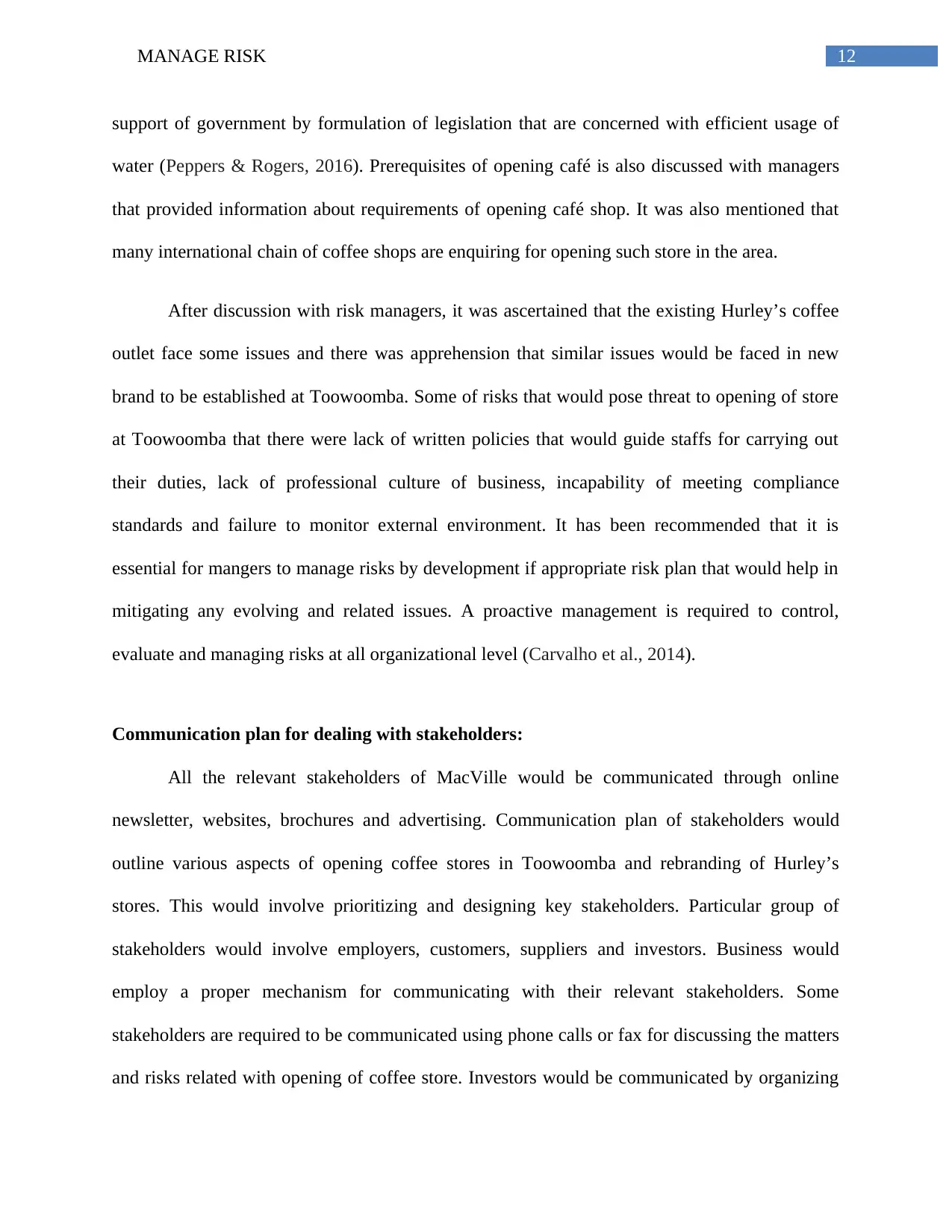
12MANAGE RISK
support of government by formulation of legislation that are concerned with efficient usage of
water (Peppers & Rogers, 2016). Prerequisites of opening café is also discussed with managers
that provided information about requirements of opening café shop. It was also mentioned that
many international chain of coffee shops are enquiring for opening such store in the area.
After discussion with risk managers, it was ascertained that the existing Hurley’s coffee
outlet face some issues and there was apprehension that similar issues would be faced in new
brand to be established at Toowoomba. Some of risks that would pose threat to opening of store
at Toowoomba that there were lack of written policies that would guide staffs for carrying out
their duties, lack of professional culture of business, incapability of meeting compliance
standards and failure to monitor external environment. It has been recommended that it is
essential for mangers to manage risks by development if appropriate risk plan that would help in
mitigating any evolving and related issues. A proactive management is required to control,
evaluate and managing risks at all organizational level (Carvalho et al., 2014).
Communication plan for dealing with stakeholders:
All the relevant stakeholders of MacVille would be communicated through online
newsletter, websites, brochures and advertising. Communication plan of stakeholders would
outline various aspects of opening coffee stores in Toowoomba and rebranding of Hurley’s
stores. This would involve prioritizing and designing key stakeholders. Particular group of
stakeholders would involve employers, customers, suppliers and investors. Business would
employ a proper mechanism for communicating with their relevant stakeholders. Some
stakeholders are required to be communicated using phone calls or fax for discussing the matters
and risks related with opening of coffee store. Investors would be communicated by organizing
support of government by formulation of legislation that are concerned with efficient usage of
water (Peppers & Rogers, 2016). Prerequisites of opening café is also discussed with managers
that provided information about requirements of opening café shop. It was also mentioned that
many international chain of coffee shops are enquiring for opening such store in the area.
After discussion with risk managers, it was ascertained that the existing Hurley’s coffee
outlet face some issues and there was apprehension that similar issues would be faced in new
brand to be established at Toowoomba. Some of risks that would pose threat to opening of store
at Toowoomba that there were lack of written policies that would guide staffs for carrying out
their duties, lack of professional culture of business, incapability of meeting compliance
standards and failure to monitor external environment. It has been recommended that it is
essential for mangers to manage risks by development if appropriate risk plan that would help in
mitigating any evolving and related issues. A proactive management is required to control,
evaluate and managing risks at all organizational level (Carvalho et al., 2014).
Communication plan for dealing with stakeholders:
All the relevant stakeholders of MacVille would be communicated through online
newsletter, websites, brochures and advertising. Communication plan of stakeholders would
outline various aspects of opening coffee stores in Toowoomba and rebranding of Hurley’s
stores. This would involve prioritizing and designing key stakeholders. Particular group of
stakeholders would involve employers, customers, suppliers and investors. Business would
employ a proper mechanism for communicating with their relevant stakeholders. Some
stakeholders are required to be communicated using phone calls or fax for discussing the matters
and risks related with opening of coffee store. Investors would be communicated by organizing
⊘ This is a preview!⊘
Do you want full access?
Subscribe today to unlock all pages.

Trusted by 1+ million students worldwide
1 out of 58
Related Documents
Your All-in-One AI-Powered Toolkit for Academic Success.
+13062052269
info@desklib.com
Available 24*7 on WhatsApp / Email
![[object Object]](/_next/static/media/star-bottom.7253800d.svg)
Unlock your academic potential
Copyright © 2020–2025 A2Z Services. All Rights Reserved. Developed and managed by ZUCOL.





